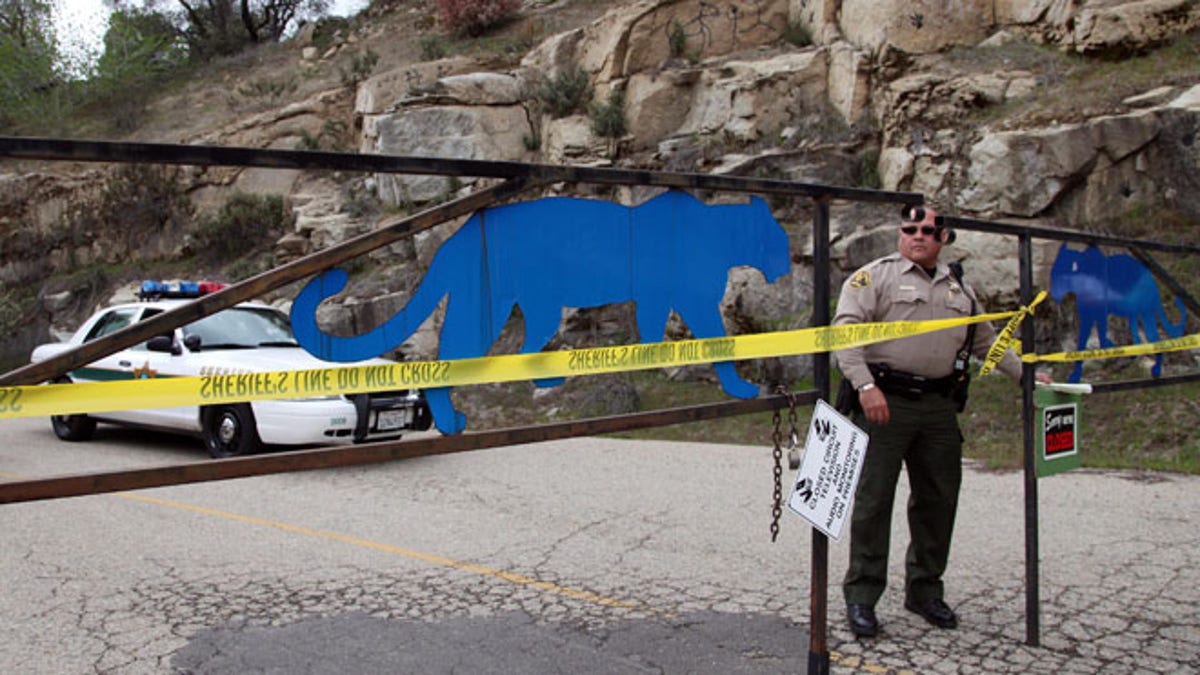
March 6, 2013: An officer guards the gate near at the entrance of Cat Haven, the exotic animal park in central California, where a 26-year-old female volunteer intern was killed by a lion, in Dunlap, Calif. (AP)
Over the past few decades, as an exotic pet trade boomed and Americans bought cute tiger cubs and baby monkeys, sanctuaries sprang up across the nation to take care of the animals that were abandoned when they reached adult-size or were no longer wanted.
The growth in both the number of wild cats as pets and the sanctuaries that rescued them has led to attacks.
Since 1990, more than 20 people have been killed by captive big wild cats at sanctuaries, zoos and private residences, more than 200 people have been mauled and 200-plus wild cats have escaped, according to one of the nation's largest wild cat sanctuaries.
The latest death is head keeper Renee Radziwon-Chapman, 36, who was killed by a cougar at an Oregon sanctuary last week.
Experts say that because sanctuaries are largely unregulated and anyone can open one, there are no uniform safety protocols. And over-confidence or human error can lead to tragic consequences even among the most experienced of caretakers.
"It's a risky business when you're dealing with dangerous wild animals. You can't leave any room for error," said Vernon Weir, director of the Nevada-based American Sanctuary Association which certifies sanctuaries.
For decades, exotic animals have been imported into the U.S. and openly bred for the pet trade. Despite new laws that limit the trade in some states, people can easily buy an African rodent, a chimpanzee, or a baby leopard at a flea market or over the Internet.
Experts estimate the U.S. exotic pet trade is a multibillion-dollar industry. Hundreds of sanctuaries have opened throughout the U.S.
About 80 sanctuaries currently house big cats, the International Fund for Animal Welfare says. Only a dozen of them are certified or verified by two certifying organizations, the American Sanctuary Association and the Global Federation of Animal Sanctuaries.
There's little governmental oversight. The U.S. Department of Agriculture, which enforces the federal Animal Welfare Act, licenses facilities that exhibit animals — whether domestic or wild — or do research. And the U.S. Fish and Wildlife Service tracks endangered species when they are bought and sold across state or U.S. borders and issues permits to facilities moving animals across state lines.
But neither agency keeps a tally on facilities or the total number of wild animals that are housed.
And no one sets rules for how sanctuaries operate.
As a result, safety procedures meant to protect staff and animals vary. Most sanctuaries develop their own protocols. The two certifying associations require safety standards, but in most cases don't define specific rules.
WildCat Haven, the Sherwood, Ore., sanctuary where the head keeper was killed on Nov. 9, was "verified" by the Global Federation of Animal Sanctuaries. Verification means the sanctuary satisfied 60 different standards, including safety.
The organization recommends "redundancy" when it comes to safety, its executive director Patty Finch said, meaning two lockout doors or two staff members present. "It won't eliminate the risk factor, but can certainly reduce it," Finch said.
Still, she said, risk is inherent in the job. "You can have the best protocols in the world and something can still go wrong."
WildCat Haven has good safety rules in place, Finch said.
Its safety manual specifies that a staff member can enter the main enclosure to clean or make repairs only after the animals are locked away in a smaller cage. Two people must be present when animals are locked up. And a caretaker can't be alone with an animal in the same space.
Sanctuary officials said Radziwon-Chapman apparently broke those rules: she worked alone, locked only one of three cougars in the smaller cage, and went into the main enclosure with the other two cougars.
The woman's family said they don't believe the wife and new mother broke any rules, and she had expressed concerns about working alone just days before the attack.
Carol Baskin, CEO of Florida-based Big Cat Rescue, which compiles data on big cat attacks and deaths throughout the nation, said locking animals into a smaller cage may not be enough.
At Big Cat Rescue, all cleaning and feeding is done from outside the cages using long poles with hooks.
"I think the vast majority of sanctuaries are not strict enough and have a tendency to perpetuate the notion that these animals can be handled safety if you're trained properly," Baskin said.
The fatal mistakes, experts say, usually happen due to human nature.
"There is a certain psychology at work when you work with these animals day in, day out," said Weir of the American Sanctuary Association. "You begin to feel comfortable around them. But they're still wild animals, you don't know what can set them off, and the results can be tragic."
The best way to stop the attacks, experts say, is to reduce the need for sanctuaries by the curtailing the exotic pet trade.
In recent years, new state laws and a ban on the trade in big cats across state lines as pets reduced the number of mauling and deaths, the data show. A few states instituted restrictions on ownership, breeding and sale of exotic pets — some banning the practice outright, while others requiring permits or liability insurance to keep such pets.
Experts say proposed national legislation that would prohibit the private possession and breeding of big cats could further reduce the need for sanctuaries and the number of attacks on humans.
"If we were able to stop the flow of cubs," Baskin said, "we would be able to stop these kinds of tragedies."

